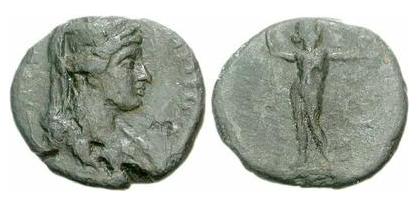S 449 - Messene, bronze, hemiobols (30-64 CE)
From SILVER
30 CE - 64 CE Bronze
Description
| ObverseInscription or printing placed on the obverse.: | MECCHNIWN (Greek).Bust of Messene right, with earring, veiled and mural crown. |
| ReverseInscription or printing placed on the reverse.: | Several types: Zeus Ithômatas right, naked, holding thunderbolt in right hand, eagle on left arm. In field, wreath (and tripod) (issues α-β), 2) Asclepios left, holding serpent-entwined staff. In field, wreath (issues γ-δ). |
Mint and issuing power
| MintIdentifies the place of manufacture or issue of a numismatic object.: | Messene | Ancient regionAncient region.: | Peloponnesus | Modern countryModern country: Greece | AuthorityIdentifies the issuing power. The authority can be "pretended" when the name or the portrait of X is on the coin but he/she was not the issuing power. It can also be "uncertain" when there is no mention of X on the coin but he/she was the issuing power according to the historical sources: | Roman Empire |
Chronology
| FromIdentifies the initial date in a range assigned in a numismatic context. | 30 CE | toIdentifies the final date in a range assigned in a numismatic context.. | 64 CE | PeriodTime period of the numismatic object.: Roman from 30 BC |
Physical description
| MetalThe physical material (usually metal) from which an object is made.: | Bronze |
Median weightMedian of the weights of numismatic objects (in grams). in grams | 5.80 | DenominationTerm indicating the value of a numismatic object. Examples: tetradrachm, chalkous, denarius.: | hemiobol |
StandardStandard.: |
Image

S_449_-_Messene,_bronze,_hemiobols_(30-64_CE).png [1]
References
| Die study referencePublication of the study: | Grandjean 20031Grandjean 2003, series XVI. | ||
| Coin series referenceReference to coin series study: | |||
Obverse dies distribution
| FrequencyFrequency of specimen in distribution. ᵖ | Number of obversesNumber of obverse dies. ᵖ (o) | % (o) | Number of coinsNumber of coins. (n) | % (n) | Die nameName(s) of the die(s). |
| 1 | 6 | 42.86 | 6 | 11.76 | 396, 397, 399, 400, 401, 402 |
| 2 | 1 | 7.14 | 2 | 3.92 | 404 |
| 3 | 2 | 14.29 | 6 | 11.76 | 395, 408 |
| 4 | 1 | 7.14 | 4 | 7.84 | 398 |
| 6 | 1 | 7.14 | 6 | 11.76 | 405 |
| 8 | 2 | 14.29 | 16 | 31.37 | 403, D407 |
| 11 | 1 | 7.14 | 11 | 21.57 | 406 |
| Total | 14 of 14 | 100 | 51 of 51 | 99.98 |
Reverse dies distribution
no distribution is available
Quantification
| Number of obversesNumber of obverse dies. ᵖ (o) | 14 | Number of singletons (o1)The number of singleton coins. ᵖ | 6 |
| Number of reverse diesNumber of reverse dies. (r) | 14 | Number of coinsNumber of coins. (n) | 51 |
| Coins per obverse dieNumber of coins per obverse die. (n/o) | 3.64 | Coins per reverse dieNumber of coins per reverse die. (n/r) | 3.64 |
| Reverse per obverse ratioRatio of obverse dies divided by reverse dies. (r/o) | 1 | Percentage of singletons (o1)number of coins (n) divided by the number of singletons (o1) ᵖ | 42.86 % |
| Original number of dies (O) (Carter 1983 formula)The estimation of the number of coins according to Carter 1983 ᵖ | 16.71 | Coins struck if 20,000 as average productivity per dieCoins made if the average productivity for obverses (according to Carter) is 20,000. ᵖ | 334,200 |
| Original number of dies (O) (Esty 2011 formula)The estimation of the number of coins according to the singleton formula in Esty 2011 ᵖ (O) | 19.3 | Survival rate if 20,000 as average productivity per dieSurvival rate if average productivity is 20,000. ᵖ | 0.00015 |
| Coverage (o = % of O) (Esty 1984 formula)Esty 1984 - coverage (% of O) ᵖ (o = % of O) | 88.24% | Die productivity if survival rate 1/2,000Average productivity if survival rate is 1/2,000. ᵖ | 6,104.13 |
| Weight of silver (in kg) if 20,000 coins per die (O = Carter formula)Carter 1983 * Median weight * 20000 (*10 if gold or electrum) ᵖ | n.a. | Die productivity if survival rate 1/5,000Average productivity if survival rate is 1/5,000. ᵖ | 15,260.32 |
Remarks